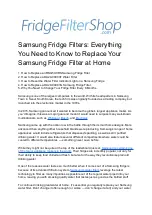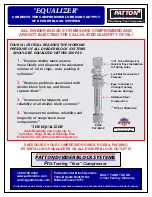
4
Parts & Service: 020 8988 7400 / E-mail: [email protected] or [email protected]
Air compressors must comply with the appropriate European Community
Safety Directives.
A build-up of moisture in the air compressor will accelerate wear and corrosion
in the air tool. Ensure any moisture is drained from the compressor daily and
the airline filter is kept clean.
If an unusually long air hose is required, (over 8 metres), the line pressure or the
hose inside diameter may need to be increased.
The air hose must be rated at least 150% of the maximum operating pressure of
the air tool.
Never exceed the maximum operating pressure for the air tool. Ensure that air
pressure does not exceed that stated in the specification for the tool when
running. Higher pressures and contaminated air will shorten the life of the air
tool due to faster wear and is a possible safety hazard.
INSTALLATION
1. Ensure the compressor is turned off and any airline pressure relieved.
2. Remove the blanking plugs from the connection ports and connect to the
supply and delivery lines.
3. Keep pipe lengths to a minimum with the inside clean. Pipe joint
compound should be used sparingly and applied only to the male pipe —
never into the female port.
4. Do not use PTFE tape to seal pipe joints — pieces have a tendency to
break off and lodge inside the unit, possibly causing malfunction. Also a
new pipe or hose should be installed between the lubricator and the
equipment being protected.
5. Install the lubricator so that air flows as marked by the arrow on the
lubricator body.
6. Installation should be downstream of any filter and regulator but upstream
of the device it is to lubricate (valve, cylinders, air tool, etc). A filter installed
upstream of the lubricator is recommended.
7. Install the lubricator vertically with the bowl drain at the bottom. Free
moisture will thus drain into the bottom of the bowl where it can be drained
off using the tap via a screw-on hose if available.
8. Ensure sufficient free space above the lubricator for future adjustments
and topping up with fresh oil.
9. Your lubricator is now ready for use.
Summary of Contents for CAT196
Page 8: ......


























